| Columns Retired Columns & Blogs |
NAD C 372 integrated amplifier Measurements
Sidebar 4: Measurements
I preconditioned the NAD C 372 by running both channels for 60 minutes at one-third the measured continuous clipping power into 8 ohms. With the amplifier cold, the THD+noise percentage was 0.0037%; it had risen very slightly after 60 minutes to 0.0046%. The top panel was also quite hot at that time—just under 60°C—but I could keep my hand on it.
The maximum voltage gain into 8 ohms was 38.1dB, 29.05dB of this coming from the power-amplifier section, 9.05dB from the preamp. Neither section inverted signal polarity; ie, the amplifier as a whole preserved absolute polarity. The input impedance was higher than specified, at >200k ohms over most of the audioband, dropping inconsequentially to 114k ohms at 20kHz. Measured at the Link jacks, the power amplifier's input impedance was a fairly low 10k ohms at all frequencies, while the preamplifier section's output impedance was a usefully low 70 ohms.
The left channel's output impedance at the speaker terminals was 0.1 ohm in the bass and midrange, rising slightly to 0.14 ohm at 20kHz. As a result of this low value, the modification of the amplifier's frequency response by the usual Ohm's Law interaction between its source impedance and that of the loudspeaker will be small (fig.1, top trace at 2kHz). This graph, taken with the tone controls defeated, also indicates that the amplifier has a wide small-signal bandwidth, the –3dB point into 8 ohms lying at 200kHz. This bandwidth did not significantly change with different volume-control settings, but it did decrease slightly into 2 ohms (fig.1, bottom dashed trace). The C 372's reproduction of a 10kHz squarewave was excellent, with no overshoot or ringing evident (fig.2).
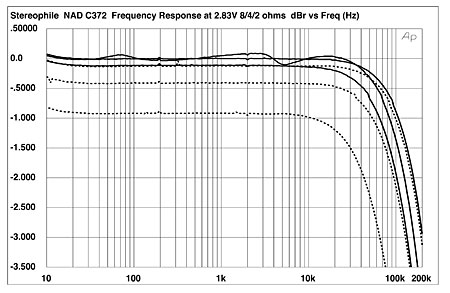
Fig.1 NAD C 372, frequency response at 2.83V into (from top to bottom at 2kHz): simulated loudspeaker load, 8, 4, 2 ohms (0.5dB/vertical div., right channel dashed).
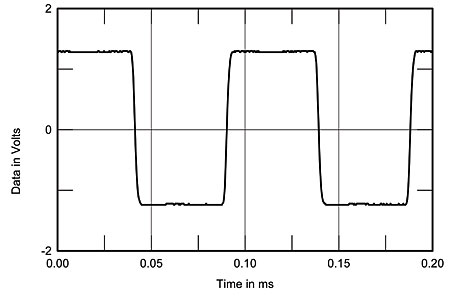
Fig.2 NAD C 372, small-signal 10kHz squarewave into 8 ohms.
Fig.1 was taken with the volume control set to its maximum; the small degree of imbalance visible in the 8 ohm traces doubles into 4 ohms, the right channel having a slightly greater output impedance. This channel imbalance also increased slightly at lower volume-control settings. Channel separation (not shown) was good rather than great, at 80dB in the midrange, decreasing at the top of the audioband to 55dB (R–L) and 67dB (L–R). The NAD's treble and bass controls have sensibly limited ranges of operation (fig.3). Assessed with the volume control at its maximum but the input shorted, the C 372's unweighted, wideband signal/noise ratio was good, at 78.5dB (left) and 78.9dB (right), both figures ref. 1W into 8 ohms. A-weighting increased the S/N ratios to 91.1dB and 94.0dB, respectively.
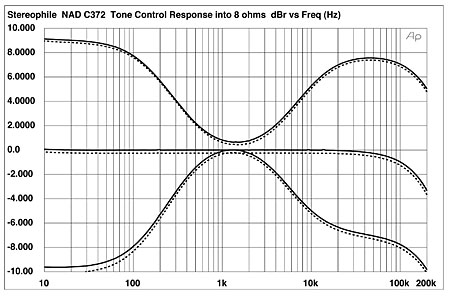
Fig.3 NAD C 372, frequency response at 2.83V into 8 ohms with treble and bass controls set to their maximum and minimum settings (2dB/vertical div., right channel dashed).
With its commutating output-stage voltage rails and the option of Soft Clipping, the NAD's maximum output power will depend on the test circumstances. Driven with a continuous tone without Soft Clipping engaged, the amplifier's plot of THD+N percentage against output power (fig.4, lower trace) was conventional, with the THD buried in the noise until just before the point where the output waveform began to square. At clipping (1% THD+N), the NAD gave out 190W with both channels driven (22.8dBW), slightly higher than the specified 180W. Engaging Soft Clipping increased the distortion above a few watts output due to the waveform rounding that occurs, and reduced the continuous 1% power to 125W into 8 ohms (21dBW, fig.4, upper trace).
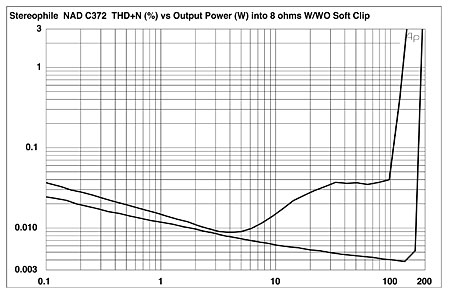
Fig.4 NAD C 372, distortion (%)vs 1kHz continuous output power into 8 ohms with soft clipping on (top) and off (bottom).
I didn't measure the maximum continuous power delivery into loads lower than 8 ohms. For that I used the Miller Audio Research Amplifier Profiler, which allows THD to be measured using a short-duty-cycle toneburst, in this case 10 cycles of 1kHz followed by 400 cycles of silence. The results of this testing with Soft Clipping off are shown in fig.5. No fewer than 300W are available at 1% THD (true sum of the distortion harmonics, horizontal magenta line in fig.5) into 8 ohms (red trace), which is 1dB higher than the continuous power rating. The C 372 delivered 535W into 4 ohms (24.3dBW, black trace), 940W into 2 ohms (23.7dBW, blue), and 1450W into 1 ohm (22.6dBW, green). The latter is equivalent to an instantaneous current of 39A, although, of course, the amplifier can maintain this current for only a very short time.
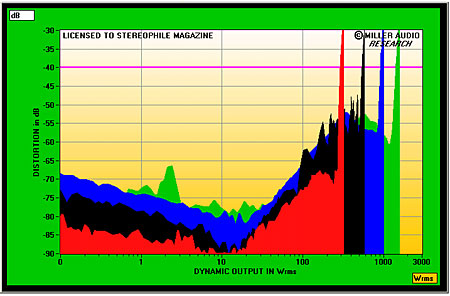
Fig.5 NAD C 372, soft clipping off, distortion (%)vs 1kHz toneburst output power (10 cycles on, 400 cycles off) into 8 (red), 4 (black), 2 (blue), and 1 ohms (green).
With Soft Clipping engaged, the maximum output power into all loads was reduced (not shown), but interestingly, the amplifier now behaved more like a perfect voltage source, its 1% THD output power on tonebursts doubling each time the load impedance was halved: 200W into 8 ohms, 400W into 4 ohms, 800W into 2 ohms, and 1430W into 1 ohm, all but the last equivalent to 23dBW (footnote 1).
Fig.6 shows how the percentage of THD+N in the C 372's output varies with frequency and load impedance, taken at a moderately high level of 10V. The distortion is very low under all conditions, though the amplifier is clearly less happy driving 2 ohms in the top audio octaves. Note also the fact that the THD+N percentage is higher from the right channel than the left. The harmonic content of the distortion at low power levels can be inferred from its waveform (fig.7) to be a combination of third-harmonic and higher-order spuriae. At high powers (fig.8), the third predominates. Note also in this graph the very low level of the power-supply–related 120Hz component. The NAD has a suitably hefty power supply for its power rating, and attention must have been paid to optimal grounding.
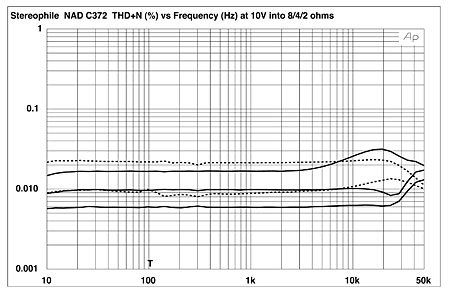
Fig.6 NAD C 372, THD+N (%)vs frequency at 10V into (from bottom to top): 8, 4, 2 ohms (right channel dashed).
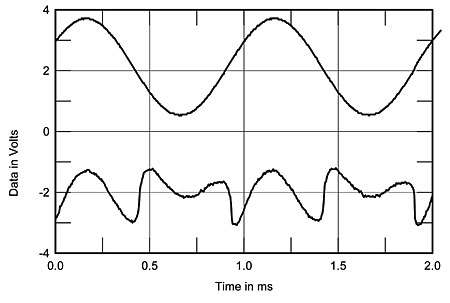
Fig.7 NAD C 372, 1kHz waveform at 5W into 8 ohms (top), 0.007% THD+N; distortion and noise waveform with fundamental notched out (bottom, not to scale).
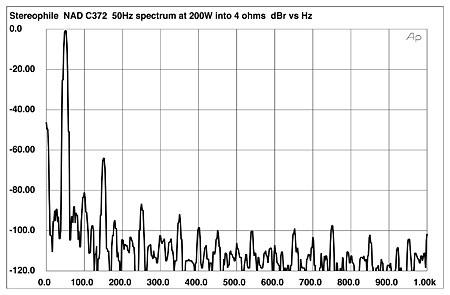
Fig.8 NAD C 372, spectrum of 50Hz sinewave, DC–1kHz, at 200W into 4 ohms (linear frequency scale).
Finally, fig.9 reveals that the C 372 produces low levels of intermodulation distortion, even at high output powers with this very demanding high-frequency signal.
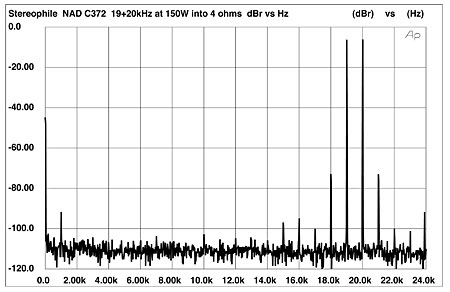
Fig.9 NAD C 372, HF intermodulation spectrum, DC–24kHz, 19+20kHz at 150W peak into 4 ohms (linear frequency scale).
All things considered, NAD's C 372 offers a very high output power and fine measured performance at a very affordable price. Its designer, Bj??rn-Erik Edvardson, has lived in England for many years, and I'm sure he would agree with my overall verdict: that the C 372 is an amplifier that is "well sorted." Well sorted.—John Atkinson
Footnote 1: When rating amplifier output power in dBW, I use the convention established by British reviewer Martin Colloms 20 years ago, which is to use an 8-ohm watt as the reference. Thus a true voltage-source amplifier will offer the same dBW rating into all impedances, which I feel is an easier paradigm to grasp than one in which the rating increases by 3dB for each halving of the load impedance.—John Atkinson
- Log in or register to post comments




































